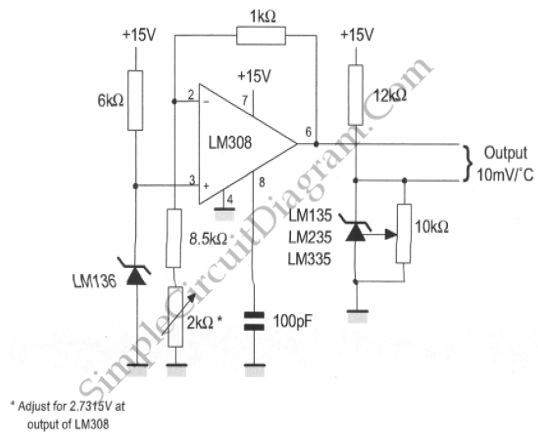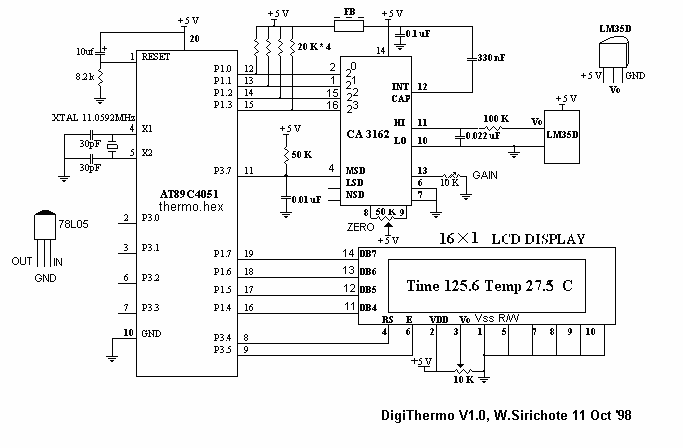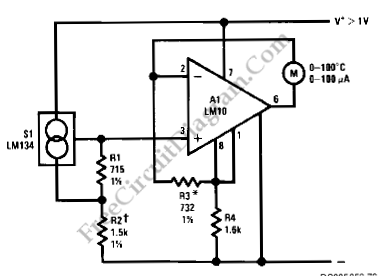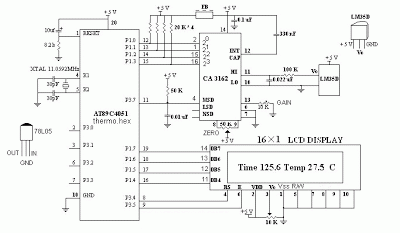
Centigrade thermometer 0-100c
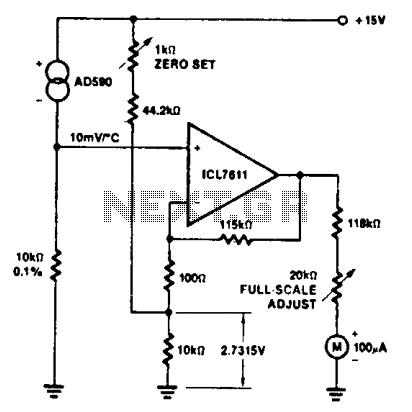
The ultra-low bias current of the ICL7611 enables the use of large-value gain resistors, maintaining meter current error below a specified percentage, thus eliminating the need for an additional meter-driving amplifier.
The ICL7611 is a precision analog-to-digital converter (ADC) with ultra-low bias current characteristics, making it suitable for applications requiring high accuracy and minimal error. The ability to utilize large-value gain resistors is particularly advantageous in temperature measurement systems, such as a centigrade thermometer operating in the range of 0 to 100 degrees Celsius.
In this application, the ICL7611 can be integrated into a temperature sensing circuit where a thermistor or a similar temperature-sensitive resistor is used to detect temperature changes. The resistance of the thermistor varies with temperature, which can be converted into a voltage signal suitable for the ICL7611 input.
The circuit typically includes a voltage divider configuration, where the thermistor is paired with a fixed resistor to create a measurable voltage output corresponding to the temperature. The gain resistors connected to the ICL7611 amplify this voltage signal, ensuring that it falls within the optimal input range of the ADC. The ultra-low bias current of the ICL7611 minimizes the input current error, allowing for accurate temperature readings without the need for additional amplification stages.
To further enhance the circuit's performance, careful consideration of the layout and component selection is essential. Using precision resistors for the gain configuration and ensuring proper decoupling of the power supply can significantly improve the overall accuracy and stability of the temperature measurement system.
In summary, the integration of the ICL7611 in a centigrade thermometer circuit not only simplifies the design by reducing component count but also enhances measurement precision, making it an ideal choice for high-performance temperature sensing applications.The ultra-low bias current of the ICL7611 allows the use of large-value gain-resistors, keeping meter-current error under Yt%, and therefore saving the expense of an extra meter-driving amplifier. Centigrade thermometer 0-100c.
The ICL7611 is a precision analog-to-digital converter (ADC) with ultra-low bias current characteristics, making it suitable for applications requiring high accuracy and minimal error. The ability to utilize large-value gain resistors is particularly advantageous in temperature measurement systems, such as a centigrade thermometer operating in the range of 0 to 100 degrees Celsius.
In this application, the ICL7611 can be integrated into a temperature sensing circuit where a thermistor or a similar temperature-sensitive resistor is used to detect temperature changes. The resistance of the thermistor varies with temperature, which can be converted into a voltage signal suitable for the ICL7611 input.
The circuit typically includes a voltage divider configuration, where the thermistor is paired with a fixed resistor to create a measurable voltage output corresponding to the temperature. The gain resistors connected to the ICL7611 amplify this voltage signal, ensuring that it falls within the optimal input range of the ADC. The ultra-low bias current of the ICL7611 minimizes the input current error, allowing for accurate temperature readings without the need for additional amplification stages.
To further enhance the circuit's performance, careful consideration of the layout and component selection is essential. Using precision resistors for the gain configuration and ensuring proper decoupling of the power supply can significantly improve the overall accuracy and stability of the temperature measurement system.
In summary, the integration of the ICL7611 in a centigrade thermometer circuit not only simplifies the design by reducing component count but also enhances measurement precision, making it an ideal choice for high-performance temperature sensing applications.The ultra-low bias current of the ICL7611 allows the use of large-value gain-resistors, keeping meter-current error under Yt%, and therefore saving the expense of an extra meter-driving amplifier. Centigrade thermometer 0-100c.
